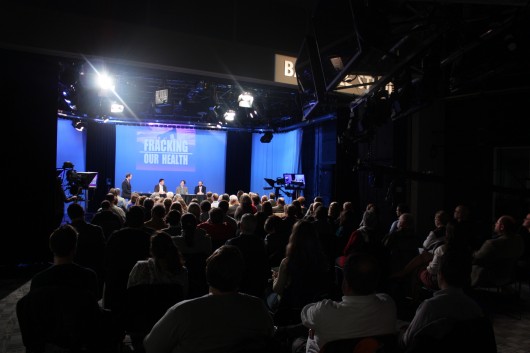An Ohio State professor said too little is known about the process and effects of fracking to deem it safe or unsafe.
The Thursday panel was part of Fracking Our Health, a discussion focused on separating fact from fiction on the issue of fracking.

Panelists discuss the effect of Hydraulic fracturing on the environment. From left: moderator Mike Thompson, OSU professor Mike Bisesi, Yale University Law School professor Daniel Kahan and Columbus Dispatch editor Mark Somerson. The panel was held at COSI March 6.
Credit: Sam Harrington / Lantern photographer
Hydraulic fracturing, commonly known as fracking, is a process of natural gas extraction that consists of pumping water, sand and chemicals into the earth and cracking the rock layer so natural gas can be released. Subsequently the water becomes radioactive. Some people are said to believe the method causes more harm than good, while others disagree, said moderator and WOSU news programming director Mike Thompson.
Fracking hasn’t yet had the appropriate amount of study to determine if the method’s potential negative effects are strong enough to warrant alarm, the panel concluded.
For Ohio, fracking is a relatively new method of extracting energy and because of its visual nature, it’s been “volatile” for some people, but little is known about it, said panelist Mark Somerson, The Columbus Dispatch science, environment and medical editor.
“The undisputed fact is that (fracking) is here. There are not a lot of facts about whether it’s good for you or bad for you yet,” Somerson said.
While the panel did not take a stance on the method itself, it did seek to find out how fracking was being discussed and whether it has been represented accurately.
One popular misnomer is that fracking’s waste can cause human sickness, said panelist Mike Bisesi, an OSU professor of environmental health sciences and senior associate dean of academic affairs.
“There is no data, that I am aware of, showing a direct link to human disease,” Bisesi said. He added that fracking has some risk, as other forms of energy do, but risk does not mean disease.
A problem with how fracking has been represented is that it is often talked about in a vacuum that does not include other forms of energy, said panelist and Yale University Law School professor of law and psychology Daniel Kahan.
“There’s a kind of distortion in focusing on one form of technology in isolation from the others,” Kahan said. “You want to know all of the potential risks associated with fracking … but you also want to know what the risks are of alternatives to fracking.”
Much research still needs to be done on fracking before it can be labeled as safe or unsafe and any conclusions are, at this point, “premature,” Bisesi said.

Panelists discuss the effect of Hydraulic fracturing on the environment at a panel held March 6 at COSI.
Credit: Sam Harrington / Lantern photographer
Some audience members found the discussion useful because so many unknowns surround the issue, said Columbus resident Daniel Ingwersen, adding that it is the “social responsibility” of Ohioans to become aware of fracking’s potential harm.
Other audience members said they appreciated the panel’s objective stance.
“I feel like it was good … that they were not talking about, ‘Are we for or against it?’ but ‘How are we coming off to the public?’” said Kate Dye, a second-year in environmental studies at Columbus State Community College. “It’s not just an activist issue, it’s an everyone issue.”
The event, which more than 80 people attended, was held in a television studio at Columbus’ Center of Science and Industry.
It was a part of a televised series on WOSU sponsored by the Health Science Frontiers in collaboration with OSU’s School of Communication and others.


